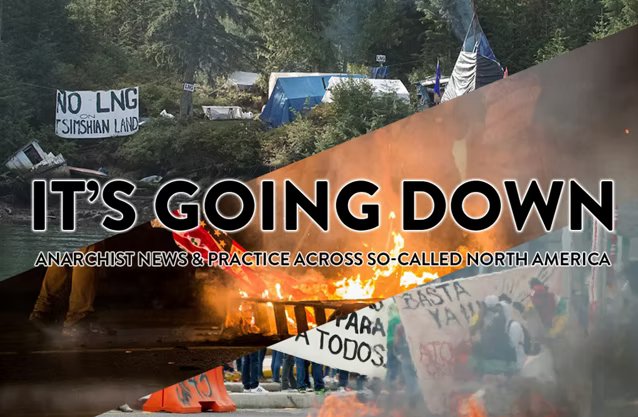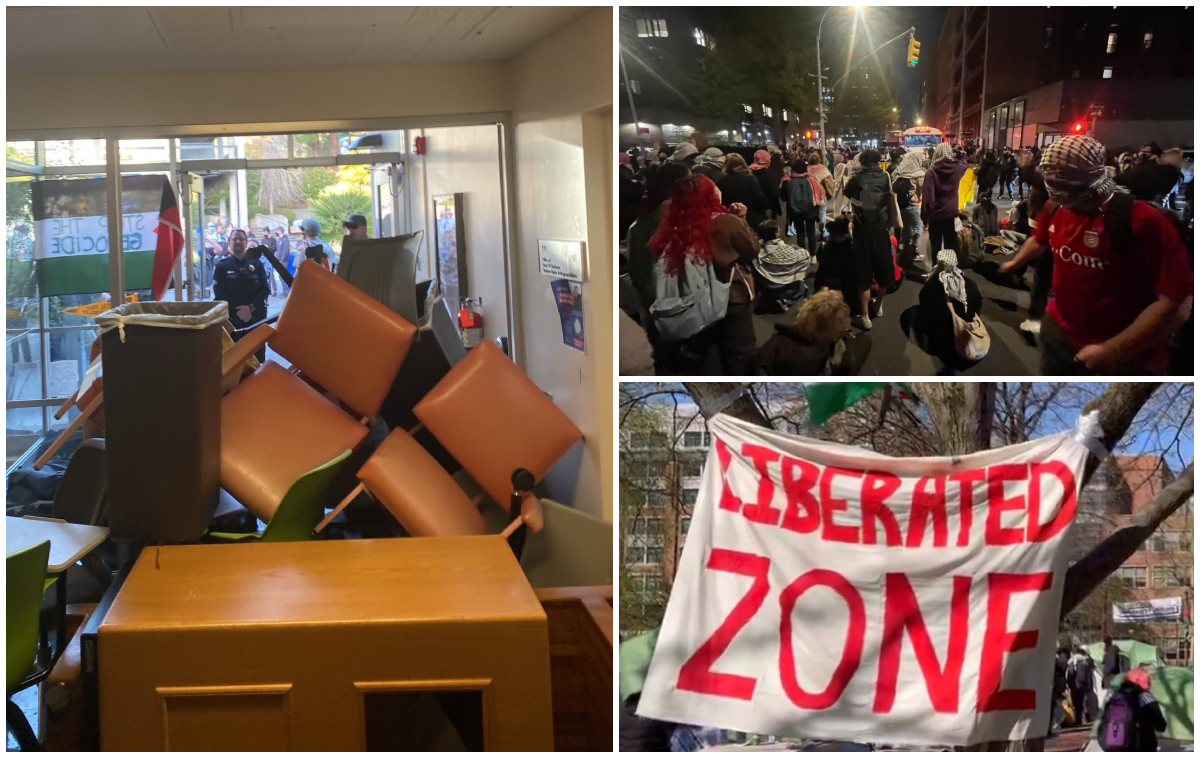Filed under: Capitalism, Critique, Southern Mexico

Originally posted to It’s Going Down
The following essay is teaser to a larger interview with the Dorset Chiapas Solidarity group that will be published in the coming days.
IGD: How does the Mexican state respond to autonomous movements?
Besides the military/paramilitary organization strategy, the most common—and for that reason most violent—way in which the state responds to any attempt at autonomy is through what they call federalism, and co-optation.
‘Federalism’ was first established in the constitution of the ‘independent’ Mexico in 1824, in which the term ‘municipio’ was introduced to the constitution to delimit the basic political, economic and legal unit for the administration of the resources and means of production of a territory, under the excuse of local sovereignty. With a ‘democratically elected’ presidente municipal at the head of each ayuntamiento, this is the foundation of the federation’s governability and the beginning of all political and economic centralization. Federalism is the name in Mexico for centralism –as many of the most corrupt governors of the recent past recognize- but not centralism of any kind.
The regime of Mexico should be defined as centralized presidential despotism. The ‘democratic’ succession of power both in the centre of the federation and its peripheries has always been that of dedazo and tapadismo. Later the confusion between voting for democratic rule served only as an alternative for the governor to keep the preferred ‘party’ of each municipality in power, for him to win his own governmental election in each state; in turn this served the president of the federation and republic to keep his own party ruling in the entire territory. In 1929, the state, by making claims of being the inheritor of the ideas of the revolution, managed to establish a centralized bureaucracy that has co-opted all sorts of revolutionary ideas by disguising them under the labels of ‘reforms for progress.’
This is the regime first established by the modern capitalist class born in the 1920s, and later continued after the 1940s as a contract between the business class and the ruling class. The president of the federation is the representative of this capitalist class, but pretends to be the representative of the federation by claiming that municipalities are able to choose what they want as long as they don’t violate the constitution. In turn, the constitution says that the federation has to both collect the incomes of the municipalities and to give back basic services and push forward the municipalities towards ‘progress’, ‘modernity’, etc… The municipality is never seen as able to give back as much as what the federation gives to it, and hence it is in a condition of constant debt, the federation always requiring more from it. During a first period in Mexican history, every attempt of real social change was seen as counter-revolutionary, but in the later years any revolutionary attempt was been seen as non-progressive, or as utopistic, naive and so on.
The municipality has been the unit in which two kinds of autonomy have been fought for in the recent years. The first kind can be labelled simply as clientelist municipal autonomy and is both electoral and asistencialist. For most of its history it has been sheer despotism how the municipal presidents were established. There were two options, either being for the ruling class represented by a single ruling party (PRI, and its father the PNR) or against it. Whenever it become impossible for the clients to keep up with the economic and political debt imposed by the patron or federation, hence worsening the situation of the dominated, the dominated citizens, mixed with other sometimes middle class interests, somehow managed to force their presidente to fulfil more commonly basic needs, such as food, electricity, etc… In recent times sometimes this has been done by voting for a different party, but in this situation other parties, the PAN, PRD and more recently MORENA, although sometimes also the PRI, have taken advantage of the situation of debt of the citizens in a municipality to established their own agendas in their search for federal power, rather than fighting for municipal freedom, and the requests of the communities.
The central power is somehow vaguely aware of the humanitarian crisis in poor municipalities and so, to keep its power, it creates centralized aids to bring some basic needs, but not all, to the municipalities, in so far as the municipalities keep the loyalty to the central power. This is the reason underneath all asistencialismo. Asistencialismo is what defines the latest visit of Velazco Coello to the municipalities in the vicinity of the Abejas of Acteal, this is the Cruzada contra el hambre, the Programa Solidaridad, the Conasupo, all forms of participación ciudadana, are nothing but a form of governability to co-opt autonomy and the search for self-governance in order to assure basic needs.
Whenever asistencialismo takes place, then a higher debt is imposed on the municipalities and discontent is divided among the citizens who receive the migajas or crumbs given by the patron. The governor and the presidente municipal assume that they have done a lot but that more has to be done and then tell the municipalities that they have to do what they are told to do, claiming that what they lack can be solved by implementing a social technique or a technology, hence dismissing and diminishing the political problems underlining the exertion of political power, of domination, exploitation, land grab and pillage. In the fear of losing more than what they’ve already lost, most citizens of Mexico are forced to succumb to different forms of asistencialismo.
Today, due to the new development of capitalism, the government wants to get rid even of all forms of asistencialismo, which sometimes the dominated see as a victory of the people, always inevitably saying that they don’t have the money to sustain it because they have to pay debts. Politicians conveniently fail to see the debt that they have to their citizens of fulfilling what they want, and so whenever a municipal president is too dreadful for the ruling power because either he/she/they believes that a social change is needed, or because he used the police or the organized crime or a combination of both to suppress dissent and keep his own tiny kingdom, then he is killed.
Very often the client patron relationships established between parties and citizens and parties and criminal organizations and the business class end up in killings. This is why so many municipal presidents have been killed in the past years, in particular relation to the elections of 1988, the elections of Oaxaca prior to 2006 and since then, and in Guerrero, and this is the reason why the estimation that at least 70% of the municipalities are infiltrated by drug cartels must be false. A study should be conducted in this sense, to prove this hypothesis wrong, but such a study must contemplate that never has there been a division between the state and drug cartels, rather the division has been among members of different businessmen in single municipalities. Because that’s what the drug cartels are, business corporations wanting the exact same things, through different means, as the ruling class. From drug cartels and their violent struggle a new layer of new rich and powerful men was added to the capitalist social class, fighting mostly for plazas and for putting their own candidates in municipalities
The struggle for real autonomy, from the Jaramillistas to the Zapatistas, and more recently, in Iguala, has also been fought in municipalities. The case of Rubén Jaramillo is exemplary in this sense, because he tried the political way, by organizing the agrarian party of Morelos, as well as two armed struggles and ending in land occupations in the 60s, which are in reality reparations of a history of oppression. Jaramillo was shot, in fact, under the orders of the ‘leftist’ president López Mateos.
Some communities have never succumbed to asistencialismo, or to fear, and thanks to them the real fight for real autonomy has been led. This is partly because municipalities have the poorest and most exploited and marginalized citizens in Mexico, and because whether the ruling party likes it or not, and in spite of all its attempts to eradicate all municipal freedom, article 115 of the constitution does in fact grant some legal independence giving some little tiny margin to fight for greater and real autonomy. Very often it is the ejido which is the first space of reclaimed autonomy, think for example of the Ejido de Tila or Bachajón where more than 400 ejidos were reclaimed. The Zapatistas were successful in creating the MAREZ. But there are other examples of municipal autonomy, like that of the Municipio Autónomo de San Juan Copola.
After the disappearance of the 43 students in Guerrero, at least 5 municipalities declared autonomy from the federal government, claiming to have the right to have their own police, and their own rules. When the state was unable to respond to the CRAC and UPEG, backed up by large sectors of the Mexican society which were in agreement with the normalistas, a popular coalition called for the cancellation of powers in Guerrero and for cancelling the elections. All the factions of the state responded to this with either political or actual violence, hence repressing the demonstrations against the elections in Guerrero, which ended up in the murder of compa Toño and professor Claudio of the teachers’ union, and also displaying all the power of the state by bringing acarreados to reassure of the ‘effectiveness’ of the electoral ‘democracy’.
Similar struggles happened in Cherán, not without bloodshed, which has also reclaimed political independence by not having elections to choose their leaders. Cherán seems to be an example of how things can go better when everything around you is quite wrong. The phenomena of criminal organizations and state terrorism combined have prompted many communities to establish their own police, also called autodefensas, and to try to have independence from drug cartels and the federal government at once. But in Michoacán and in other places almost inevitably the autodefensas have, by participating with the government, given way to the participation and collaboration with drug cartels. In other words, it seems that there cannot be real autonomy without it being autonomy from capitalism.
The ruling capitalist class fears real autonomy. Similar to their ancestors—the constitutionalists who advocated for Mexico to remain as part of the colonies of the Spanish empire—the new capitalist class (established mostly by Salinas) wants to create a mando único policial which implies the disappearance of the municipal armed forces (i.e. police), cancels the right of municipalities to have their own police and political independence, and puts instead a single federal armed body. What this mando único does is to ensure that the capitalists will still take most, if not all the profit of the municipalities; regardless of the situation and un-comfortableness of each locality, it seeks to dismantle the legal autonomy given to municipalities by the federation having organised crime as an excuse. Therefore, in all cases of autonomy, whether clientelist or real, the state being the representative of the capitalist ruling class responds with violence, when it is necessary, but more commonly with asistencialismo and other practices of governability such as participación ciudadana.





